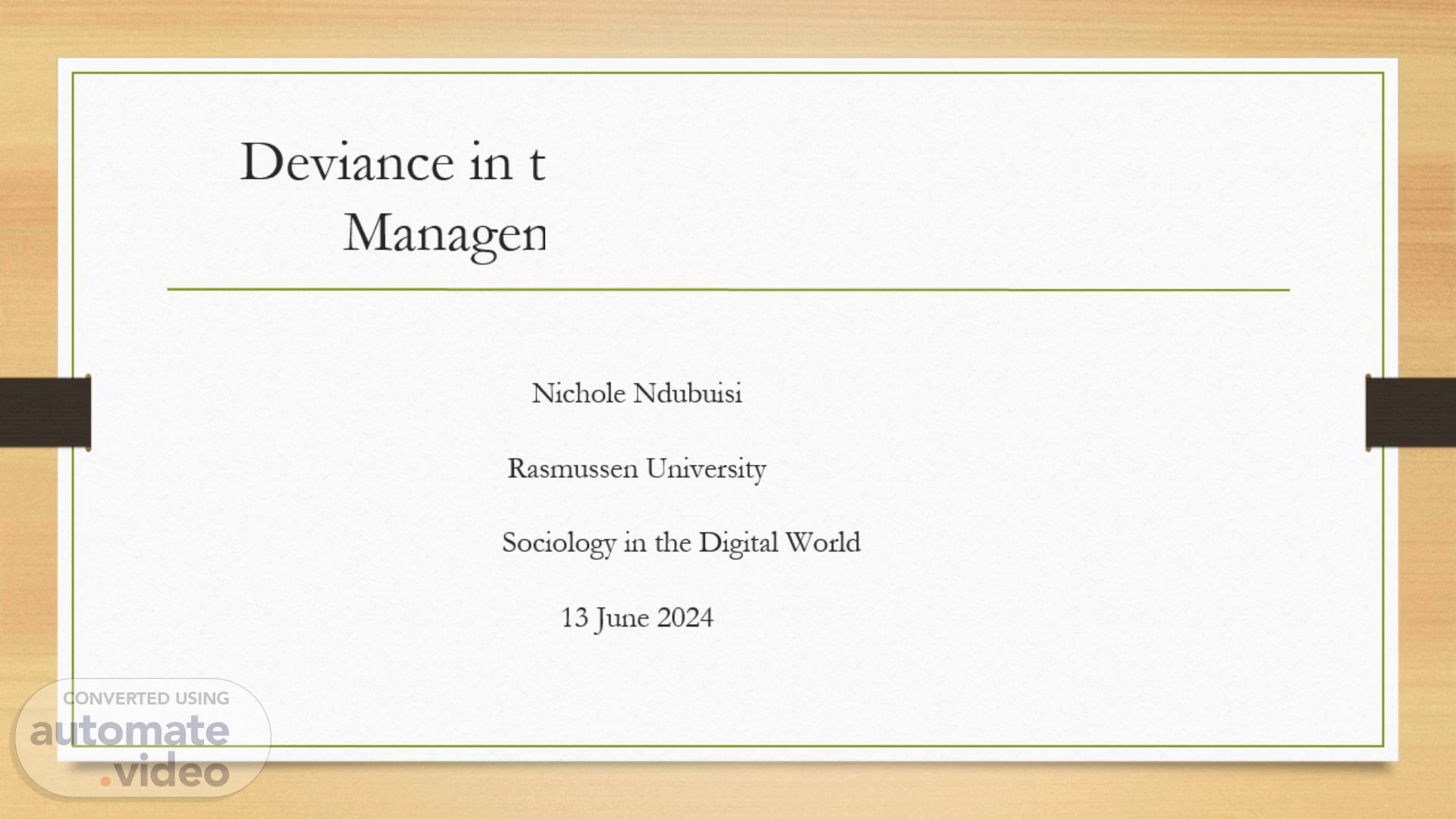
Page 1 (0s)
Deviance in the Digital World: Impact and Management in Retail Operations.
Page 2 (10s)
Understanding Deviance in the Physical World. Definition: Behavior that violates social norms and expectations. Typically includes actions deemed unacceptable by societal standards. Examples: Theft: Stealing merchandise from the store. Vandalism: Damaging store property. Harassment: Inappropriate behavior towards staff or customers. Impact on Society: Erodes public trust and creates an unsafe environment. Leads to increased costs for security measures and legal actions. Can result in a loss of business if customers feel unsafe..
Page 3 (32s)
Understanding Deviance in the Digital World. Definition: Online behaviors that violate norms and regulations. Includes activities that harm others or violate legal standards. Examples: Hacking: Unauthorized access to the store's digital systems. Cyberbullying: Online harassment of employees or customers. Identity Theft: Stealing personal information for fraudulent use. Impact on Society: Can cause significant financial losses and emotional distress. More challenging to detect and control compared to physical deviance..
Page 4 (55s)
Comparing Physical and Digital Deviance. Similarities: Both types of deviance undermine social order and trust. Both can lead to financial and emotional harm. Both require resources for prevention and response. Differences: Digital deviance can occur anonymously and reach a larger scale. Physical deviance is more visible and immediate, making it easier to detect. Digital deviance often involves more complex, technological methods..
Page 5 (1m 15s)
Theories of Deviance. Conflict Theory: Suggests that deviance arises from social inequalities and power differentials. The powerful define what is considered deviant to control the less powerful. Examples: Laws against hacking protect corporations more than individuals. Symbolic Interaction Theory: Proposes that deviance is learned through interactions with others. The meaning of deviance is shaped by societal reactions and labels. Examples: A hacker community may view their actions as skillful rather than deviant..
Page 6 (1m 37s)
Theories Applied to Digital Deviance. Conflict Theory: Influenced by unequal access to technology. Corporate interests shape online deviance. Symbolic Interaction Theory: Online communities normalize deviant behaviors. Social media and peer influence perpetuate deviance..
Page 7 (1m 51s)
Impact of Digital Deviance on Retail Operations. Potential Threats: Data breaches, loss of customer trust. Online scams targeting reputation and finances. Disruption through cyberattacks. Consequences: Financial losses, increased security costs. Legal liabilities, regulatory fines. Damage to brand reputation, customer loyalty..
Page 8 (2m 7s)
Strategies for Managing Deviance. Preventive Measures: Implement advanced cybersecurity protocols. Regular training on recognizing and responding to threats. Operational Strategies: Clear policies and consequences for deviance. Monitor online activity for signs of deviance. Foster positive work culture to reduce internal deviance. Responsive Actions: Crisis management plan. Transparent customer engagement during incidents. Collaboration with law enforcement and cybersecurity experts..
Page 9 (2m 26s)
References. Ferrell, J., Hayward, K., & Young, J. (2019). Cultural Criminology: An Invitation (2nd ed.). SAGE Publications. Goffman, E. (2018). The Presentation of Self in Everyday Life. Anchor Books. Liska, A. E., & Messner, S. F. (2018). Perspectives on Deviance. Prentice Hall. Marwick, A. E., & Lewis, R. (2017). Media Manipulation and Disinformation Online. Data & Society Research Institute. https://datasociety.net/pubs/ia/DataAndSociety_MediaManipulationAndDisinformationOnline.pdf Nash, K. (2018). Cybercrime and Society. SAGE Publications. Ponemon Institute. (2020). Cost of a Data Breach Report 2020. IBM Security. https://www.ibm.com/security/data-breach Wall, D. S. (2017). Crime and Deviance in Cyberspace. Routledge. Wall, D. S. (2020). Policing Cybercrime: Networked and Social Media Technologies and the Challenges for Policing. Polity Press. Whitman, M. E., & Mattord, H. J. (2018). Principles of Information Security (6th ed.). Cengage Learning..